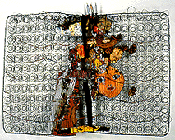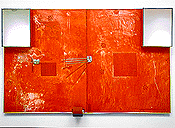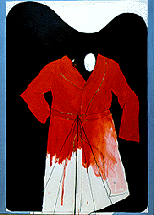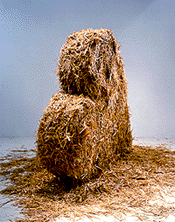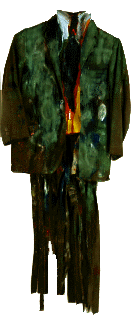 Green Suit, 1959 Mixed-media assemblage 166.7 x 73 cm Private collection, New York Photo by Ellen Page Wilson, courtesy PaceWildenstein |
During the first ten years of his professional career, Jim Dine began his lifelong pursuit of the themes of the self, the body, and memory through a variety of mediums--painting, performance, mixed-media assemblage, and sculpture. JIM DINE: Walking Memory, 1959-1969, presented on Ramps 4, 5, and 6 and in Towers 5 and 7 of the Solomon R. Guggenheim Museum, traces this multifaceted exploration of personal identity in more than 100 works, including his environments and performance pieces (as documented in photographs). Apparent in nearly all Dine's early works are his use of everyday objects as surrogates for the body, a focus on iconic imagery, and an interest in evoking or naming things through the written or spoken word in conjunction with their visual equivalents. Dine arrived in New York from Ohio in 1958 and quickly established himself within the avant-garde art scene. The Judson Gallery, which opened at the beginning of 1959 in the basement of the Judson Memorial Church in Manhattan's Greenwich Village, provided him with the first forum to show his work in New York and, in 1960, the opportunity to create his first environment, The House, and to stage his first performance piece, The Smiling Workman. These opportunities were augmented by his parallel association with the Reuben Gallery, a home to many of the Happenings orchestrated by fellow artists such as Allan Kaprow. During this period, Dine began combining painting and objects (found objects or store-bought items) to create collage-paintings and assemblages that are highly emotional and personal in content. Among these are a group of self-portraits from 1959, such as a series of painted and collaged heads that evoke children's art, and the assemblage Green Suit; with their vigorous brushstrokes, these works echo the Abstract Expressionists'concern with the process of painting as a means of articulating the self. |
|
Many of Dine's mixed-media assemblages, such as Untitled (Winged Victory) (1959) and Bedspring (1960), draw on the grit of the everyday for their impact, incorporating discarded clothing, bedsprings, and other trash salvaged from the city's streets. The Smiling Workman was performed at the Judson Gallery in the winter of 1960. Standing onstage in a painter's smock, Dine scrawled the words "I love what I'm doing, HELP!" across a large canvas. He punctuated this declaration by drinking what appeared to be red paint (actually tomato juice) and then pouring the rest of it over his head and body. Dine's wry nod to his Action Painting predecessors culminated in a dive through the canvas, a literal transgression of the division between the corporeal reality of the painter and the artifice of the painting that would remain a focus of his work throughout the decade. |
|
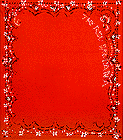 |
|
|
Emotional distress resulted in Dine's withdrawal from the social scene of the New York art world for a few years during the early 1960s. The advent of his involvement with psychoanalysis, starting in 1962, profoundly influenced his work from that point onward, with Dine incorporating objects to form a symbolic language with which he could articulate his memories. In his series of Tool paintings, a hammer or axe applied like a stroke of paint, or a sickle dangling from the canvas by a length of twine, recalls the years Dine spent working in his family's hardware stores in Ohio and Kentucky. In two series of assemblages, one focusing on bathrooms and the other on children's rooms, household furnishings such as mirrored medicine cabinets, metal bathroom fixtures, or a child's bedside lamp (as in Child's Blue Wall, 1962) jut from the canvas and involve the viewer physically in Dine's remembrances, establishing a dialogue between the spectator and the work. |
|
|
|
Dine also began to address his identity and physicality through images of thickly painted palettes (or actual palettes affixed to canvases) and oversize color charts, which suggest the basic artifacts of his profession and the presence of the artist. Such references to the self became more direct in 1964 in a series of assemblages featuring images of men's suits and in another series based on an illustration of a bathrobe that Dine saw in a newspaper advertisement. A typical example isPalette (Self-Portrait No. 1) (1964), in which the robe is sharply delineated and decorated with physical objects (a chain, a watch) and seems to anticipate inhabitation by the artist's body. Dine went further in exploring his ideas about objects in a series of painted, three-dimensional sculptures of tools, furniture, and boots that he began making during a two-year hiatus from painting, starting in 1966. The cool objectivity of the Pop art movement, with which such pedestrian imagery was irrevocably linked, contrasted with the intimate articulations of Dine's work and provoked art historian Alan Solomon's 1967 essay about Dine, "Hot Artist in a Cool Time." |
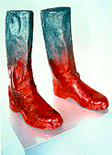 A Nice Pair of Boots, 1965 Enamel paint on cast bronze. Two boots: 40.6 x 27.9 x 10.2 cm each Sonnabend Collection. Photo courtesy Sonnabend Gallery Photo by Susan Einstein |
|
|
As Dine's sculptures became larger, his interest in manipulating the space of the viewer became more pronounced, in works such as Nancy and I at Ithaca (Green) (1966-69), Nancy and I at Ithaca (Straw Heart) (1966-69/98), and Five Chicken-Wire Hearts (for James Peto) (1969/98), featuring a mammoth hand or enormous hearts. The written word, which had appeared in many of his works earlier in the decade, gained new prominence when Dine resumed painting in 1968. In a literal transcription of his memory onto the canvas, he inscribed the name of every person he could recall from his past in two Name Paintings (both 1968-69). Dine's concerns during this decade are summed up in Colour of the Month of August (1969), in which bold strokes of paint are juxtaposed with the names of the colors scrawled on the canvas, underscoring the self-referential nature of the artist's words and images within a more abstract visual language. Both tactile and cerebral, Dine's work from 1959-69 discloses the origins of a multifaceted oeuvre that has continued to diversify. --Kara Vander Weg, Project Curatorial
Assistant JIM DINE: Walking Memory, 1959-1969 has been co-curated by Germano Celant, Senior curator of Contemporary Art, and Clare Bell, Associate Curator for Prints and Drawings at the Solomon R. Guggenheim Museum. Support has been provided by the Florence Gould Fondation. |

